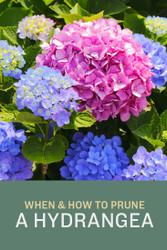Featuring new bypass Pruner from February/March 2022 catalog.

Japanese Garden Tools Vs. American: What’s the Difference?
You may have seen Japanese gardening tools popping up more in stores and online. Sure, they&rs… Read More

Featuring new bypass Pruner from February/March 2022 catalog.
A hydrangea is kind of like a pair of well-made shoes: when cared for properly, it can last forever. Also like a well-made pair of shoes, not all hydrangeas require the same kind of care. People can find hydrangeas tricky to manage, but following a few simple tips will keep you in flouncy blooms all season long, for years to come.
First, figure out if your hydrangea blooms on old wood or new wood, because this will determine when you need to prune. Is it a climbing or oakleaf hydrangea? Does it bloom in the early summer and lose steam by the end of July? Then it’s an old wood-bloomer and should be pruned right as the blossoms begin to fade, in the summer. Panicle, smooth, and bigleaf (e.g. mophead and lacecap) hydrangeas are new wood bloomers, and should be pruned in late winter, right before they wake up for spring — February is ideal — or as they go dormant for fall. Either way, snip off dead blooms just below the flower head to keep the shrub looking tidy.
Whichever type of hydrangeas you have, the most important thing is to start with a pair of clean, sharp bypass loppers and prune back the dead blooms and spindly canes. Both old wood and new wood hydrangeas will benefit from being cut back hard — to just a couple inches from the soil line if you want the biggest blooms. Old wood hydrangeas like to have the old canes pruned back to promote new growth, but new wood hydrangeas can get a bit floppy if you don’t leave a few old canes to prop them up. If you want the big blossoms without the flop, you can use stakes to support the blooming canes — but pruning the canes at different heights means blooms at different heights, which can create a fuller overall effect.
For the most part, shrubs benefit from some maintenance, and that generally means pruning. That said, you can leave the dead blooms on mophead hydrangeas in the fall to protect the buds over the winter — just make sure you snip them off in early spring to give the new growth some breathing room, and you’ll be rewarded with vigorous growth.
Featuring new bypass Pruner from February/March 2022 catalog.
A hydrangea is kind of like a pair of well-made shoes: when cared for properly, it can last forever. Also like a well-made pair of shoes, not all hydrangeas require the same kind of care. People can find hydrangeas tricky to manage, but following a few simple tips will keep you in flouncy blooms all season long, for years to come.
First, figure out if your hydrangea blooms on old wood or new wood, because this will determine when you need to prune. Is it a climbing or oakleaf hydrangea? Does it bloom in the early summer and lose steam by the end of July? Then it’s an old wood-bloomer and should be pruned right as the blossoms begin to fade, in the summer.
Panicle, smooth, and bigleaf (e.g. mophead and lacecap) hydrangeas are new wood bloomers, and should be pruned in late winter, right before they wake up for spring — February is ideal — or as they go dormant for fall. Either way, snip off dead blooms just below the flower head to keep the shrub looking tidy.
Whichever type of hydrangeas you have, the most important thing is to start with a pair of clean, sharp bypass loppers and prune back the dead blooms and spindly canes. Both old wood and new wood hydrangeas will benefit from being cut back hard — to just a couple inches from the soil line if you want the biggest blooms. Old wood hydrangeas like to have the old canes pruned back to promote new growth, but new wood hydrangeas can get a bit floppy if you don’t leave a few old canes to prop them up. If you want the big blossoms without the flop, you can use stakes to support the blooming canes — but pruning the canes at different heights means blooms at different heights, which can create a fuller overall effect.
For the most part, shrubs benefit from some maintenance, and that generally means pruning. That said, you can leave the dead blooms on mophead hydrangeas in the fall to protect the buds over the winter — just make sure you snip them off in early spring to give the new growth some breathing room, and you’ll be rewarded with vigorous growth.